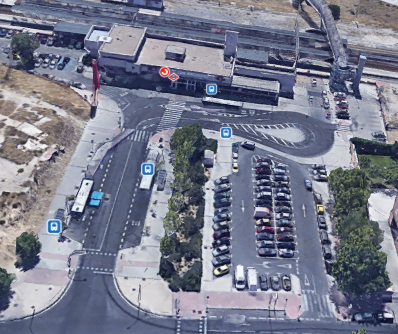Lorena de la Fuente Sanz
Deterrent parking are car parks located on the periphery of large cities, and in some cases in medium-sized cities, with the aim of drivers parking their private vehicles in these car parks and accessing the city center by public transport. These types of spaces should be located in places with good connections with public transport in order to facilitate the transfer as much as possible. It is, therefore, an interchange that encourages the intermodality between public and private transport.
Likewise, the dissuasive car parks must comply with a series of characteristics to encourage it use and to meet the established objectives. The most outstanding singularities that these facilities must possess are that they must be used in a long stay, otherwise they could be used systematically as parking for small periods of time, as well as having a low price and having an integrated prepaid parking card. -public transport. On the other hand, communications with public transport should be comfortable and should allow easy and fast access to public transport facilities. In addition, it is important that these car parks are attractive for drivers, thus persuading their use, such as the installation of service establishments for vehicles and travelers as leisure and shopping facilities that may be of interest to users of these car parks.
The reasons that have led to the incorporation of this type of solutions are multiple and common in large cities, and they are increasing, so it is absolutely necessary to adopt these measures. These solutions are attributed significant environmental, territorial and socioeconomic impacts. Among the most important causes to adopt these solutions are traffic congestion in the center of these urban centers that significantly deteriorate the quality of life of citizens, with a high rate of accidents, high levels of pollution and a considerable impact to public health and the environment. Other reasons, is the increase in the dispersion of cities, against densification, which hinders the provision of public service and dependence on the vehicle itself that exists today.

In this type of project, it is interesting to carry out an analysis of the consequences, not only in the short term, but also the effects they will have on the long-term future.
On the one hand, the short-term effects of dissuasive car parks are the change in mobility associated with it, a change in citizens’ habits, an improvement in the quality of life and well-being of citizens, less traffic congestion, less accidents, fewer environmental and public health problems due to pollution, and a greater space dedicated to pedestrians and the improvement of their accessibility.

On the other hand, the long-term consequences that would occur in the future are a change in spatial planning along with a change in the mentality of the citizen in terms of the location of homes and workplaces that constitute forced mobility , reducing the distances between them, and thus increasing non-motorized transport and the use of public transport, together with an increase in purchasing power since the expenses generated by the vehicle itself, such as fuel costs, insurance, maintenance, and parking space, are much greater than those caused by the use of public transport. In addition, this change in spatial planning foresees an increase in population density, which leads to an improvement in the provision of the public service with greater frequencies and greater lines, an increase in local commerce in the decrease of the large commercial areas located in the periphery, and the use of part of the public space occupied by the road and parking spaces for places of leisure and shopping for the enjoyment of citizens.
In conclusion, this measure aims to significantly reduce traffic congestion that currently exists in large cities with all that this implies, such as improving the quality of life, increasing accessibility and the welfare of citizens, the reduction of the accident rate, improvement of the environmental quality, and the reduction of noise, atmospheric pollution and emissions of greenhouse gases. In addition, all this leads to a change of mentality in terms of mobility and an increase in the use of public transport that will provide the territory with a greater space dedicated to the enjoyment of pedestrians.
